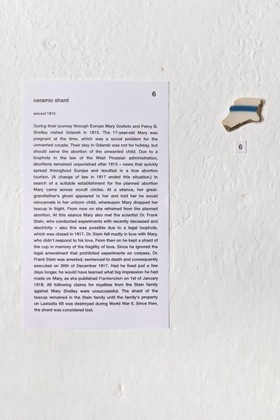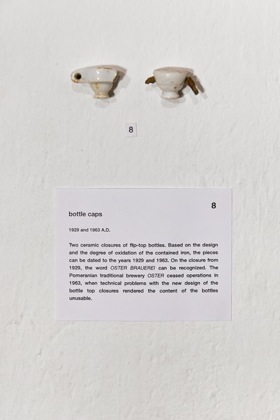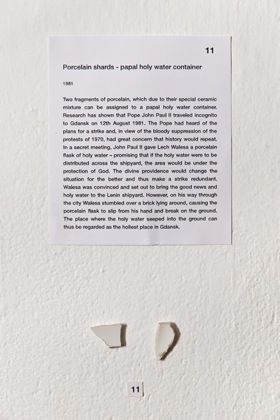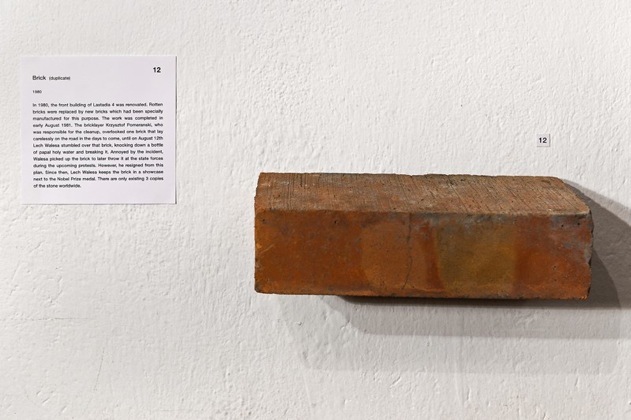Human thighbone – Saint Mariejohann
1157 A.D.
On the basis of a DNA comparison with known relics, the bone fragment could clearly be assigned to Saint Mariejohann. The little-known Saint (whose real name was Johannes Maria Grünlich) lived from 1130 to 1157. He is the patron saint of the daydreamers. Contemporaries write about Saint Mariejohann that throughout his entire life he was specially noticible for nothing unusual. He is said to have spent most of the day daydreaming, yet always in a dazzling mood. The exact circumstances of his death are still unclear. According to rumors, he had a raid on his person during which he remained in his usual good mood, which resulted in his untimely end.
Ceramic insulation
1884 A.D.
The ceramic insulation can be assigned to an early version of the Tesla coil. Little is known that Nicola Tesla spent a few weeks in Gdansk in spring of 1884 to visit his study friend – and presumed lover – Piotr Stadianski. In the joint weeks in Stadianski Laboratorium, the two made crucial breakthroughs in the study of electromagnetic felds. Many of Tesla's later patents go back to the work with Stadianski. Shortly after Tesla left for America in June 1884, Piotr Stadianski committed suicide. In his farewell letter, Stadianski describes his time with Tesla as the "most fulflling time of his life".
ceramic shard
around 1815
During their journey through Europe Mary Godwin and Percy B. Shelley visited Gdansk in 1815. The 17-year-old Mary was pregnant at the time, which was a social problem for the unmarried couple. Their stay in Gdansk was not for holiday, but should serve the abortion of the unwanted child. Due to a loophole in the law of the West Prussian administration, abortions remained unpunished after 1815 – news that quickly spread throughout Europe and resulted in a true abortion tourism. (A change of law in 1817 ended this situation.) In search of a suitable establishment for the planned abortion Mary came across occult circles. At a séance, her great-grandfather's ghost appeared to her and told her he would reincarnate in her unborn child, whereupon Mary dropped her teacup in fright. From now on she refrained from the planned abortion. At this séance Mary also met the scientist Dr. Frank Stein, who conducted experiments with recently deceased and electricity – also this was possible due to a legal loophole, which was closed in 1817. Dr. Stein fell madly in love with Mary, who didn't respond to his love. From then on he kept a shard of the cup in memory of the fragility of love. Since he ignored the legal amendment that prohibited experiments on corpses, Dr. Frank Stein was arrested, sentenced to death and consequently executed on 30th of December 1817. Had he lived just a few days longer, he would have learned what big impression he had made on Mary, as she published Frankenstein on 1st of January 1818. All following claims for royalties from the Stein family against Mary Shelley were unsuccessful. The shard of the teacup remained in the Stein family until the family's property on Lastadia 4B was destroyed during World War II. Since then, the shard was considered lost.
bottle caps
1929 and 1963 A.D.
Two ceramic closures of fip-top bottles. Based on the design and the degree of oxidation of the contained iron, the pieces can be dated to the years 1929 and 1963. On the closure from 1929, the word OSTER BRAUEREI can be recognized. The Pomeranian traditional brewery OSTER ceased operations in 1963, when technical problems with the new design of the bottle top closures rendered the content of the bottles unusable.
broken bottles
1939
The shards show the text fragments "... ufich" and "Gesetz ...". This shows the bottles as pieces of German production. They can be assigned to the Bavarian breweries Buflich and Gesetzneder. On the basis of these shards fnally the whereabouts of the German soldiers Hermann Bufich and Hans Gesetzneder could be clarifed. In the fles of the Wehrmacht of 1939, the two soldiers are stated as deserters. No further record exists of their whereabouts. The youth friends Bufich and Gesetzneder were said to have had a great deal of curiosity and a thirst for adventure as well as a propensity for disobedience. A friend of the family wrote from the SMS Schleswig-Holstein to the family Bufich, that he worries the two friends would take off on their own to visit the Pomeranian traditional brewery OSTER even though the army command had announced alarm for the following day (the 1st of September 1939).
Metal Screw
undated
A metric screw of the type M12/50. The galvanization perished and consequently the humidity in the ground has lead to heavy oxidation of the steel which rendered the screw unusable. This specifc screw is of absolutely no special signifcance. Furthermore it carries nothing but the greatest pettiness for any known historiography. It is neither the bolt of a german airplane nor was it a part of the engine of MS Batory. It is a screw. Just a screw. Nothing but an old rusted screw.
Porcelain shards
papal holy water container
1981
Two fragments of porcelain, which due to their special ceramic mixture can be assigned to a papal holy water container. Research has shown that Pope John Paul II traveled incognito to Gdansk on 12th August 1981. The Pope had heard of the plans for a strike and, in view of the bloody suppression of the protests of 1970, had great concern that history would repeat. In a secret meeting, John Paul II gave Lech Walesa a porcelain fask of holy water – promising that if the holy water were to be distributed across the shipyard, the area would be under the protection of God. The divine providence would change the situation for the better and thus make a strike redundant. Walesa was convinced and set out to bring the good news and holy water to the Lenin shipyard. However, on his way through the city Walesa stumbled over a brick lying around, causing the porcelain fask to slip from his hand and break on the ground. The place where the holy water seeped into the ground can thus be regarded as the holiest place in Gdansk.
Brick (duplicate)
1980
In 1980, the front building of Lastadia 4 was renovated. Rotten bricks were replaced by new bricks which had been specially manufactured for this purpose. The work was completed in early August 1981. The bricklayer Krzysztof Pomeranski, who was responsible for the cleanup, overlooked one brick that lay carelessly on the road in the days to come, until on August 12th Lech Walesa stumbled over that brick, knocking down a bottle of papal holy water and breaking it. Annoyed by the incident, Walesa picked up the brick to later throw it at the state forces during the upcoming protests. However, he resigned from this plan. Since then, Lech Walesa keeps the brick in a showcase next to the Nobel Prize medal. There are only existing 3 copies of the stone worldwide.
Fossilized potato
approx. 50.000 B.C
The latest finding from the Lastadia Cultural Excavation Site was made after the Collection was first publicly exhibited. It might be the most spectacular discovery of the entire excavation. The 3,4 cm long artifact is a fossilized wild potato that could be dated to 50.000 B.C.. Hereby it is the oldest fossilized potato ever found. Previous findings of wild potato fossils in Chile were dated to 13.000 B.C.. This finding proves that potatoes originate from middle-east Europe. Speculations about the european origins of the potato were already made by the Belgian biologist Fritz Gunter Pomm in 1896 after eating an original peruvian potato stew which reminded him of a stew he had eaten before in the Pomeranian area. F. G. Pomm was convinced of the european origins of the potato and dedicated his further research towards bringing proofs. His contemporaries mocked him for his believe and his research was not taken seriously as he couldn't make plausible how the potato plant came from Europe to South America. Pomm developed three possible scenarios to make his claim credible. First he speculated that potatoes were part of the diet of the early inhabitants of Europe and had been taken along in the process of migration. This thesis wasn‘t accepted, as it would include the idea of early agriculture, which is widely rejected. Pomm‘s second thesis was that Vikings had brought the potato to America and had introduced the plant, which they had discovered on a previous raid in the Baltic, to the natives. This thesis was also not accepted, as the claim, that the vikings had crossed the atlantic before Columbus, was rejected by the Scientific community. Pomm‘s last attempt to proof his theory was the Seagull thesis. Pomm speculated on seagulls carrying potatoes across the Atlantic in the attempt to resettle their colonies. Even with many experiments Pomm could neither proof that a seagull would be able to carry a potato over a such long distance, nor that seagulls would mistake potatoes for their eggs. In 1912 Fritz Gunter Pomm was reported missing during an expedition in the Andes. In memory of this dauntless scientist, the species of early european potato was named Solanum Europaensis Pommensis.








